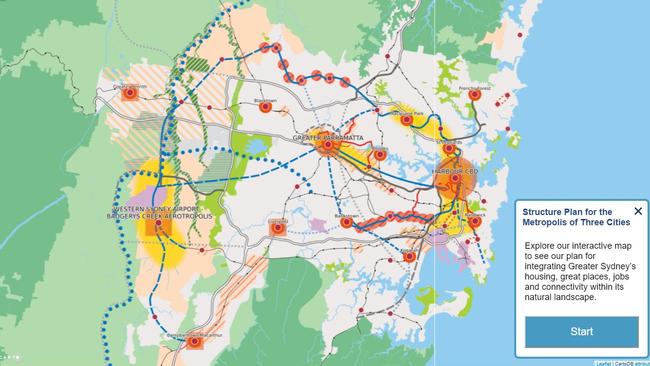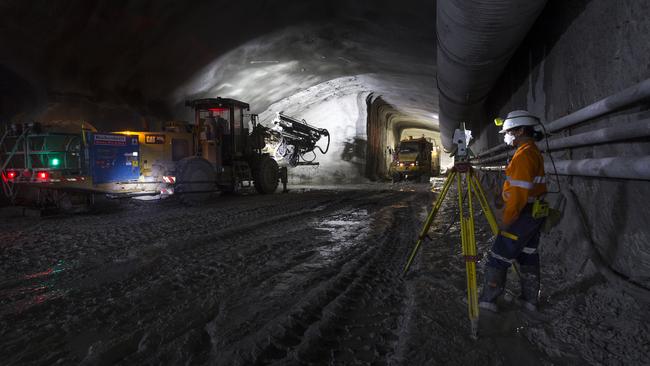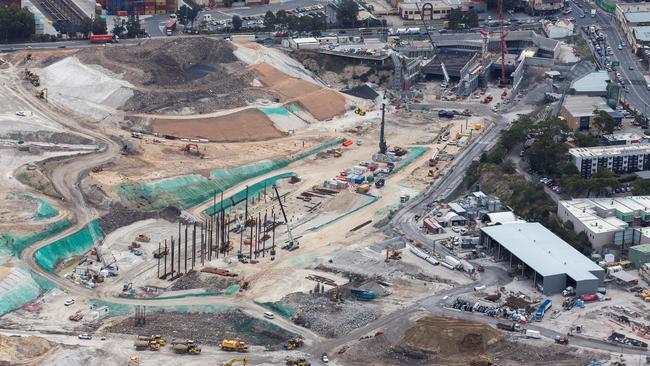Predictions about the future are notorious for being wrong. They can be apocalyptic, like the late 1960s bestseller The Population Bomb, which terrified a generation with predictions that Western nations would soon face mass starvation as a result of overpopulation.
Then there’s the other extreme: utopian fantasies such as the Jetson-style flying cars, frequently touted as being “just around the corner” — a promise made every decade since they were first described by science fiction writer Jules Verne in 1904.
Despite the difficulties of predicting the future, the consequences of getting it wrong are far worse, say a growing legion of planners struggling to effectively design Sydney’s future.
The M4’s smart motorway will use real-time technology to monitor and control traffic
Recently released landmark government reports and strategies paint the picture in stark terms.
“Doing nothing is not an option,” Infrastructure Australia boss Philip Davies says. “If we take an unplanned path, key measures for Sydney’s global liveability ranking including access to jobs, schools, housing and access to parks will become far worse.”
We’re expecting another million residents to arrive in the next 10 years, another million on top of that in 20 years and possibly 2.7 million within 30 years.

In a sign of how serious the issue is, this week Premier Gladys Berejiklian called for an entire COAG meeting of all state premiers and the PM to be dedicated to the issue of immigration and planning next year. “We cannot ignore the reality that communities are feeling growing pressures on local services and infrastructure,” she said.
What are today’s growing pains for Sydney could well end up a full-blown coronary by 2050, complete with choked arteries seizing up a city. Parramatta is predicted to have the housing density of today’s London, while Sydney’s inner ring suburbs will reach Singapore levels.
By 2036 there will be an extra 2.7 million more daily car trips, rail trips will double and the demand for freight — the trucks and containers on the roads — will grow 62 per cent.
Port Botany reaches its operational capacity by 2040 without a new 24-hour train line being built to ship all those big containers out to the distribution hubs in the western suburbs.
Right now, in Sydney’s morning peak, 15 per cent of all kilometres travelled are on roads that “exceed capacity”. In other words they are at a standstill. That will double to 30 per cent in three decades, Infrastructure Australia predicts.
And that’s under a planning scenario of consolidated urban density, where the inner ring and middle ring suburbs of Sydney are filled with more flats, not more urban sprawl.
“Virtually all of the key roads along the Parramatta to Sydney CBD, Sydney CBD to airport, and airport to Liverpool corridors already exceed capacity in the morning peak,” Roads and Martime Services officials told a recent parliamentary inquiry into tolling. “As time progresses, congestion on these corridors is forecast to worsen.”
The Berejiklian government is digging billions of dollars’ worth of new underground freeways around the city, and promises these will cut travel times.
Another way of coping with the traffic can be seen in the $470 million spend on the state’s first “Smart Motorway” on the M4 between the foot of the Blue Mountains at Lapstone to Mays Hill, to open in two years.
It will use real-time technology to monitor and control traffic, including entry ramp traffic lights to control the flow of cars joining the motorway.

When WestConnex is completed, motorists will be able to travel between the Anzac Bridge or St Peters and Penrith without stopping at a single traffic light. It will transform the way motorists, freight and services move through the city, with 40 minutes projected to be cut from an average peak journey between Parramatta and Sydney Airport.
With roadheaders working 24/7, cranes in the sky and hundreds of pieces of machinery above and below the ground, the project has become a driver of economic growth in NSW.
Currently there is a 3900-strong workforce helping deliver major road projects, including 1000 who make the journey underground every day with two-thirds of the project being built underground.
But, according to two of the state’s top planners, people are going to be driving less cars in the future and driverless vehicles will help take traffic off the roads.
NSW Department of Planning’s deputy secretary Brendan Nelson, who doesn’t own a car and uses GoGet vehicles, speculates we may have reached peak car now.

“The younger generation coming through now are less reliant on cars,” he says. “They are not rushing out to get their licence at 17. They are not doing all of these things perhaps we did.”
Chief planner for the department Gary White says the department does not own a car, but uses GoGet vehicles.
“GoGet is a great example of the new economy, the sharing economy. Instead of everyone owning a car, people share a car,” he says.
The planners believe driverless vehicles will result in fewer cars on roads because people will just dial one up instead of having their own.
Several of the recent reports into how Sydney will cope with the population boom raise the issue of a lack of health infrastructure, with hospital services growing by 50 per cent in 20 years.

That’s partly because of an ageing population. In its report on how Sydney will cope, Infrastructure Australia estimates only 8 per cent of residents from Blacktown North will be able to get to a hospital in 20 minutes by 2046. The figure for Bringelly and Green Valley residents would be just 13 per cent. “Adequate access to hospitals is a critical requirement for all people across our cities, regardless of where they live,” the report states.
But NSW planners say digital technologies and telemedicine will help solve some issues. “You probably will be at home with your sick child, you will probably have a sensor or receptor you can put on your child and it will probably download data like when you go to a car when you get car diagnostics checked,” Nelson says.
But first they have to get hospitals digitally connected.
According to Building Momentum, the state’s official infrastructure strategy, released last month, 40 per cent of NSW Health’s built infrastructure is now more than 50 years old but will need to be retrofitted to enable doctors and nurses to use digital technology properly.
“This is a significant challenge due to the age and condition of some older property assets,” the policy states. “Many sites need to be retrofitted with digital connectivity infrastructure and power supply.”

Another issue is schools. Student numbers will climb by up to 77 per cent on today’s numbers due to immigration and higher birthrates, the departmental planners say — but there’s not enough space for them all.
One solution is to cut down the size of schools, with primary school grounds already shrinking from an average three hectares to 1.5 hectares, while high schools have been cut from six hectares to 2.5 hectares.

Another answer, according to the planners, is high rise. And a third option is to turn some single-sex high schools into co-ed schools, converting selective schools into comprehensive ones with just selective streams and combining more primary schools with secondary ones.
The Greater Sydney Commission proposes Sydney be recast as “a metropolis of three cities” — the CBD, Parramatta and a new city based around the second airport at Badgerys Creek. The vision is to spread more jobs across the entire region, within 30 minutes of most residents.
But regardless of whether that takes off, another headache for government is that many of the state’s assets are ageing and will need massive amounts of money to bring them up to scratch.
Sydney Water estimates a 10 per cent increase in demand for water would cause it to run out within seven years without additional supplies. Even our sewerage network is likely to need “billions of dollars” of extra capital by 2035 to cope with all the extra waste.

“Governments a century ago were good infrastructure providers,” says Professor Peter Murphy, an expert on cities and knowledge economies from La Trobe University. “In Sydney they built fine buildings, good roads, decent public transport networks, and fine parks and gardens. Today infrastructure has dropped way down the government priority list.”
He says people choose to live in big cities for the higher incomes, greater wealth and jobs. “The key to economic growth is productivity,” Murphy says. “Big cities, if they are well organised, generate high productivity. They amplify talent, energy and human interaction. They multiply the impact of ideas.” But successful cities typically face two major problems, he says — affordable housing and efficient infrastructure.
“Planning is notoriously hit-and-miss. The lesson from China, the world’s big infrastructure spender, is that about half of major projects work well. The rest don’t.”


British theatre impresario aims to give Sydney what it needs
Howard Panter is back in Australia and determined to give Sydney exactly what it needs: more buzz.
Pokies slap-down: Minister issues stunning directive to gaming authority
Tensions between the Minns government and the Independent Liquor and Gaming Authority have boiled over, with the Minister declaring ILGA is “not authorised” to make its own policy.